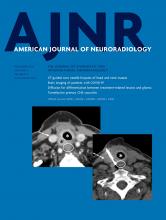Index by author
Campion, T.R.
- Adult BrainOpen AccessBrain Imaging of Patients with COVID-19: Findings at an Academic Institution during the Height of the Outbreak in New York CityE. Lin, J.E. Lantos, S.B. Strauss, C.D. Phillips, T.R. Campion, B.B. Navi, N.S. Parikh, A.E. Merkler, S. Mir, C. Zhang, H. Kamel, M. Cusick, P. Goyal and A. GuptaAmerican Journal of Neuroradiology November 2020, 41 (11) 2001-2008; DOI: https://doi.org/10.3174/ajnr.A6793
Cervo, A.
- InterventionalYou have accessUse of Cangrelor in Cervical and Intracranial Stenting for the Treatment of Acute Ischemic Stroke: A “Real Life” Single-Center ExperienceA. Cervo, F. Ferrari, G. Barchetti, L. Quilici, M. Piano, E. Boccardi and G. PeroAmerican Journal of Neuroradiology November 2020, 41 (11) 2094-2099; DOI: https://doi.org/10.3174/ajnr.A6785
Chamaraux-tran, T.-N.
- InterventionalOpen AccessStroke Thrombectomy in Patients with COVID-19: Initial Experience in 13 CasesR. Pop, A. Hasiu, F. Bolognini, D. Mihoc, V. Quenardelle, R. Gheoca, E. Schluck, S. Courtois, M. Delaitre, M. Musacchio, J. Pottecher, T.-N. Chamaraux-Tran, F. Sellal, V. Wolff, P.A. Lebedinsky and R. BeaujeuxAmerican Journal of Neuroradiology November 2020, 41 (11) 2012-2016; DOI: https://doi.org/10.3174/ajnr.A6750
Chan, L.
- Adult BrainOpen AccessDynamic CTA-Derived Perfusion Maps Predict Final Infarct Volume: The Simple Perfusion Reconstruction AlgorithmC.C. McDougall, L. Chan, S. Sachan, J. Guo, R.G. Sah, B.K. Menon, A.M. Demchuk, M.D. Hill, N.D. Forkert, C.D. d’Esterre and P.A. BarberAmerican Journal of Neuroradiology November 2020, 41 (11) 2034-2040; DOI: https://doi.org/10.3174/ajnr.A6783
Chattopadhyay, A.
- Open AccessHemorrhagic Neurologic Manifestations in COVID-19: An Isolated or Multifactorial Cause?P.S. Dhillon, A. Chattopadhyay, R.A. Dineen and R. LenthallAmerican Journal of Neuroradiology November 2020, 41 (11) E89-E90; DOI: https://doi.org/10.3174/ajnr.A6795
Cheng, N.T.
- Extracranial VascularOpen AccessCOVID-19-Associated Carotid Atherothrombosis and StrokeC. Esenwa, N.T. Cheng, E. Lipsitz, K. Hsu, R. Zampolin, A. Gersten, D. Antoniello, A. Soetanto, K. Kirchoff, A. Liberman, P. Mabie, T. Nisar, D. Rahimian, A. Brook, S.-K. Lee, N. Haranhalli, D. Altschul and D. LabovitzAmerican Journal of Neuroradiology November 2020, 41 (11) 1993-1995; DOI: https://doi.org/10.3174/ajnr.A6752
Chhabda, S.
- PEDIATRICSYou have accessDiffuse Leptomeningeal Glioneuronal Tumor of ChildhoodD.A. Lakhani, K. Mankad, S. Chhabda, P. Feizi, R. Patel, A. Sarma and S. PruthiAmerican Journal of Neuroradiology November 2020, 41 (11) 2155-2159; DOI: https://doi.org/10.3174/ajnr.A6737
Clark, B.D.
- Adult BrainYou have accessMR Imaging Features of Middle Cranial Fossa Encephaloceles and Their Associations with EpilepsyD.R. Pettersson, K.S. Hagen, N.C. Sathe, B.D. Clark and D.C. SpencerAmerican Journal of Neuroradiology November 2020, 41 (11) 2068-2074; DOI: https://doi.org/10.3174/ajnr.A6798
Cloft, H.
- InterventionalYou have accessEfficacy of Asahi Fubuki as a Guiding Catheter for Mechanical Thrombectomy: An Institutional Case SeriesL. Rinaldo, H. Cloft and W. BrinjikjiAmerican Journal of Neuroradiology November 2020, 41 (11) 2114-2116; DOI: https://doi.org/10.3174/ajnr.A6748
Cluceru, J.
- EDITOR'S CHOICEAdult BrainOpen AccessCentrally Reduced Diffusion Sign for Differentiation between Treatment-Related Lesions and Glioma Progression: A Validation StudyP. Alcaide-Leon, J. Cluceru, J.M. Lupo, T.J. Yu, T.L. Luks, T. Tihan, N.A. Bush and J.E. Villanueva-MeyerAmerican Journal of Neuroradiology November 2020, 41 (11) 2049-2054; DOI: https://doi.org/10.3174/ajnr.A6843
Images of 231 patients who underwent an operation for suspected glioma recurrence were reviewed. Patients with susceptibility artifacts or without central necrosis were excluded. The final diagnosis was established according to histopathology reports. Two neuroradiologists classified the diffusion patterns on preoperative MR imaging as the following: 1) reduced diffusion in the solid component only, 2) reduced diffusion mainly in the solid component, 3) no reduced diffusion, 4) reduced diffusion mainly in the central necrosis, and 5) reduced diffusion in the central necrosis only. A total of 103 patients were included (22 with treatment-related lesions and 81 with tumor progression). The diagnostic accuracy results for the centrally reduced diffusion pattern as a predictor of treatment-related lesions (“mainly central” and “exclusively central” patterns versus all other patterns) were: 64% sensitivity, 84% specificity, 52% positive predictive value, and 89% negative predictive value.








